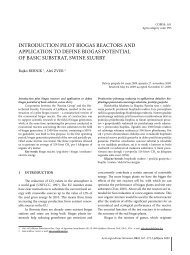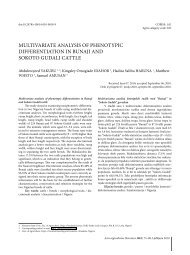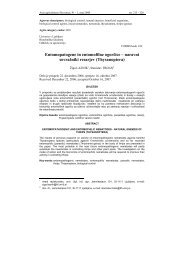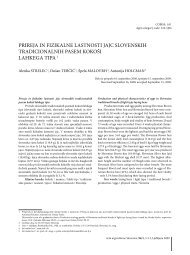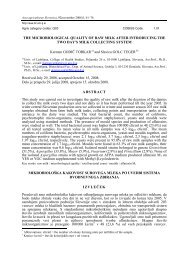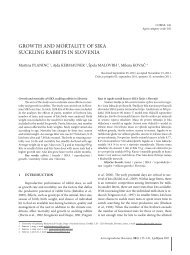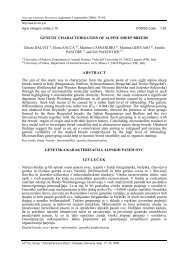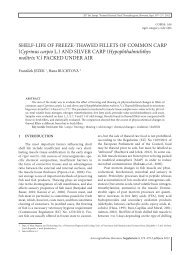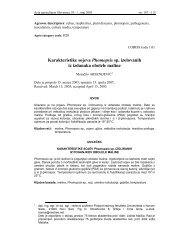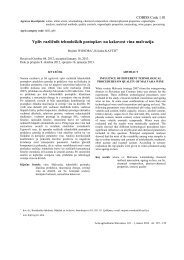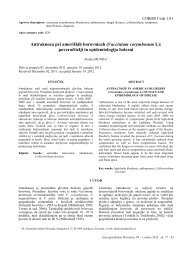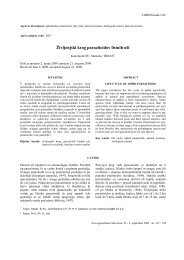ALKALIne phOSphAtASe ACtIvIty In SLOvenIAn CheeSe mADe ...
ALKALIne phOSphAtASe ACtIvIty In SLOvenIAn CheeSe mADe ...
ALKALIne phOSphAtASe ACtIvIty In SLOvenIAn CheeSe mADe ...
Create successful ePaper yourself
Turn your PDF publications into a flip-book with our unique Google optimized e-Paper software.
20 th <strong>In</strong>t. Symp. “Animal Science Days”, Kranjska gora, Slovenia, Sept. 19 th −21 st , 2012.<br />
<strong>ALKAL<strong>In</strong>e</strong> <strong>phOSphAtASe</strong> <strong>ACtIvIty</strong> <strong>In</strong> <strong>SLOvenIAn</strong><br />
<strong>CheeSe</strong> <strong>mADe</strong> frOm pASteurIzeD,<br />
thermIzeD Or rAw mILK<br />
Lena hODOŠČeK 1 , Saša rupnIK 2 , Ksenja AhČ<strong>In</strong> 2 , majda BIASIzzO 3<br />
COBISS: 1.08<br />
Agris category code: Q01<br />
AbStrACt<br />
Alkaline phosphatase (ALp) is an enzyme used as an indicator of adequate pasteurization. we measured its concentration<br />
following ISO11816-2 in pasteurized cow milk cheeses and in raw and thermized cheeses regardless of the<br />
animal species. The amount of ALp in all pasteurized cow milk cheeses (19 samples) was below 10 mu/g of cheese and<br />
as such in agreement with the tentative limit set by the european union reference Laboratory (eu-rL). The amount<br />
of ALp in raw and thermized cow cheese was 4076 and 411 mu/g of cheese, respectively. however, the concentration<br />
of ALp in raw sheep milk cheese was 8207 mu/g of cheese, due to the higher fat content of sheep milk. There was one<br />
cheese for which the heat treatment was not clearly specified by the producer. Controls of ALp activity should be carried<br />
out regularly to ensure that the legislative criteria are followed and in order to verify the correctness of cheese specifications.<br />
Keywords: cheese /pasteurization /thermization / alkaline phosphatase<br />
1 <strong>In</strong>troduCtIon<br />
Alkaline phosphatase (ALp) is an enzyme naturally<br />
occurring in all mammalian milks. Adequate pasteurization<br />
inactivates the enzyme and consequently its activity<br />
in milk can be used to demonstrate the efficiency of<br />
pasteurization. An ALp test is considered to give a negative<br />
result if the measured activity in cow milk is not<br />
higher than 350 mu/L (Commission regulation (eC)<br />
no 1664/2006). The legal limit of ALp activity in cheese<br />
made from pasteurized cow milk has yet to be determined.<br />
A tentative limit of < 10 mu/g of cheese has been<br />
proposed by the european union reference Laboratory<br />
(eu-rL).<br />
milk ALp is a dimer twisted around itself and<br />
composed of two equal length 90,000 molecular weight<br />
polypeptide chains attached to each other along their<br />
length with disulphide bridges. heat inactivated (un-<br />
folded) ALp is not capable of hydrolyzing any known<br />
substrate. unfolding of ALp is time and temperature dependent<br />
so the ALp activity level can be used as a predictor<br />
of the time and temperature regime to which milk<br />
had been subjected. measurement of the amount of residual<br />
active ALp reveals the amount of ALp that has not<br />
yet undergone unfolding and also detects the possible<br />
addition of raw milk to pasteurized milk.<br />
Since 1930 several colorimetric techniques have<br />
been developed for the measurement of ALp activity<br />
(Kay and Graham, 1935; Scharer, 1938; Aschaffenburg<br />
and mullen, 1949, cited in rocco, 2004). The first fluorometric<br />
procedure for the determination of ALp in dairy<br />
products was reported in 1990. It was based on a fluorometric<br />
substrate fluorophos (rocco, 1990a) and is therefore<br />
called the fluorophos method. It is faster and more<br />
sensitive compared to the methods developed previously<br />
(payne and wilbey, 2009). It has been approved by the<br />
1 Corresponding author. univ. of Ljubljana, veterinary fac., national veterinary <strong>In</strong>stitute, unit Kranj, Kranjska cesta 16, 4202 naklo, Slovenia, e-mail: lenahodoscek@<br />
gmail.com<br />
2 Same address as 1<br />
3 univ. of Ljubljana, veterinary fac., national veterinary <strong>In</strong>stitute, unit for food of Animal Origin, Gerbičeva 60, 1000 Ljubljana, Slovenia<br />
Acta argiculturae Slovenica, Supplement 3, 265–268, Ljubljana 2012
266<br />
L. hODOŠČeK et al.<br />
<strong>In</strong>ternational Organisation for Standardisation (ISO<br />
11816-1) and is required by the Commission regulation<br />
(eC) no 1664/2006 as a reference method for determining<br />
alkaline phosphatase activity in milk.<br />
ALp activity is measured by a continuous fluorometric<br />
direct kinetic assay. A nonfluorescent aromatic<br />
monophosphoric ester substrate undergoes hydrolysis<br />
of its phosphate radical and becomes a highly fluorescent<br />
product. ALp activity is measured in mu/L at 38 °C<br />
during 3-min read time. One unit of ALp is amount of<br />
enzyme that catalyzes transformation of 1 micromole<br />
of substrate/min/L of product. Because of the low levels<br />
of ALp in final dairy products, results are reported in<br />
milliunits/L (mu/L) (rocco, 1990a).<br />
Cheese, whose main raw material is milk, can be<br />
roughly classified according to type of milk (cow, sheep,<br />
goat), moisture content (hard, semi-hard, soft) and<br />
process of heating (raw, thermized, pasteurized), which<br />
has the greatest impact on the amount of active ALp in<br />
cheese.<br />
pasteurization is achieved by a procedure involving<br />
a high temperature for a short time (at least 72 °C<br />
for 15 seconds) and a low temperature for a long time (at<br />
least 63 °C for 30 minutes); or any other combination of<br />
time-temperature regimes to obtain an equivalent effect<br />
such that the products show, where applicable, a negative<br />
reaction to an alkaline phosphatase test immediately after<br />
such treatment (COmmISSIOn reGuLAtIOn (eC)<br />
no 2074/2005). This means that the ALp activity in cow’s<br />
milk is not higher than 350 mu/L.<br />
Thermization is a process of raw milk heating for<br />
at least 15 seconds at a temperature between 57 °C and<br />
68 °C so that after treatment the milk shows a positive<br />
reaction to the phosphatase test (rules on the veterinarysanitary<br />
inspection and control of food production establishments,<br />
the veterinary-sanitary checks and the<br />
conditions for good health standards for foodstuffs and<br />
raw materials of animal origin, 1999).<br />
Concentration of ALp in cheese depends on the<br />
milk used (raw, pasteurized or thermized milk) and varies<br />
from
<strong>ALKAL<strong>In</strong>e</strong> <strong>phOSphAtASe</strong> <strong>ACtIvIty</strong> <strong>In</strong> <strong>SLOvenIAn</strong> <strong>CheeSe</strong> <strong>mADe</strong> frOm pASteurIzeD, thermIzeD Or rAw mILK<br />
Table 1: ALP activity in cheeses made from pasteurized cow milk<br />
no type of cheese producer Cheese type heat treatment Sample2 result (mu/g)<br />
1 hard 1 local 11 pasteurized 0.79<br />
2 hard 2 local 21 pasteurized 1.58<br />
3 hard 3 local 31 pasteurized 0.61<br />
4 hard 3 local 41 pasteurized 1.02<br />
5 hard 1 local 51 pasteurized 0.46<br />
6 Semi-hard 4 gauda type pasteurized 0.59<br />
7 Semi-hard 1 local 6 pasteurized 0.69<br />
8 Semi-hard 4 local 7 pasteurized 0.60<br />
9 Semi-hard 4 local 8 pasteurized 0.74<br />
10 Semi-hard 4 trapist type pasteurized 0.66<br />
11 Semi-hard 1 edamec type pasteurized 0.76<br />
12 Semi-hard 1 local 9 pasteurized 3.17<br />
13 Semi-hard 3 local 10 pasteurized 0.86<br />
14 Semi-hard 3 local 11 pasteurized 0.59<br />
15 Semi-hard 4 local 12 pasteurized 0.51<br />
16 Semi-hard 5 local 13 pasteurized 0.96<br />
17 Semi-hard 6 fresh cheese pasteurized
268<br />
L. hODOŠČeK et al.<br />
rind, core and sample, respectively. ALp activities in the<br />
rind, centre and the sample of thermized cow cheese<br />
were 412, 315 and 411 mu/g of cheese, respectivel, with a<br />
standard deviation of only 56 mu/g.<br />
from our survey we can conclude that producer<br />
specification for cheese no 21 (table 2) regarding milk<br />
heat treatment was inconsistent with the relevant technological<br />
procedure for such type of cheese. The activity<br />
of ALp was 1.46 mu/g of cheese. This cheese type should<br />
be produced out of raw or thermized milk and should<br />
therefore have a positive reaction to the phosphatase test<br />
(rules on the veterinary-sanitary inspection and control<br />
of food production establishments, the veterinary-sanitary<br />
checks and the conditions for good health standards<br />
for foodstuffs and raw materials of animal origin, 1999).<br />
According to Annex I of Commission regulation<br />
(eC) no 2073/2005 there are different microbiological<br />
criteria for cheeses made from raw milk and milk that<br />
has undergone lower temperature than pasteurization<br />
and cheeses made from milk that has undergone pasteurization.<br />
Correct specifications and accurate information<br />
about the product are therefore crucial, also for the<br />
consumer. measurement of ALp activity can be used as<br />
a marker for potential heat treatment of the milk as well<br />
as a tool for verifying producer specifications of cheeses.<br />
4 ConCluSIonS<br />
The tested cheeses made from pasteurized cow milk<br />
in Slovenia all had ALp activities of less than 10 mu/g of<br />
cheese. we can therefore support the proposed eu-rL<br />
tentative limit of 10 mu/g of ALp for this type of chesse.<br />
<strong>In</strong> small cheese wheels, ALp is equally distributed in<br />
rind, core and 0.5 to 1.5 cm below the rind. ALp activity<br />
could potentially be used not only for testing milk pasteurization<br />
but also for verifying producer specifications.<br />
5 ACKnowledgeMent<br />
The authors sincerely thank Dejan Dolenc and nataša<br />
noč for all the help with analyses and dr. Suzana Žižek<br />
for revising the manuscript.<br />
Acta agriculturae Slovenica, Supplement 3 – 2012<br />
6 referenCeS<br />
COmmISSIOn reGuLAtIOn (eC) no 2074/2005 of 5 December<br />
2005 laying down implementing measures for certain<br />
products under regulation (eC) no 853/2004 of the<br />
european parliament and of the Council and for the organisation<br />
of official controls under<br />
regulation (eC) no 854/2004 of the european parliament and<br />
of the Council and regulation (eC) no 882/2004 of the<br />
european parliament and of the Council, derogating from<br />
regulation (eC) no 852/2004 of the european parliament<br />
and of the Council and amending regulations (eC) no<br />
853/2004 and (eC) no 854/2004. Off J eu 2005, L338: 27-<br />
59<br />
COmmISSIOn reGuLAtIOn (eC) no 2073/2005 of 15 november<br />
2005 on microbiological criteria for foodstuffs. Off<br />
J eu 2005, L338: 1–26<br />
COmmISSIOn reGuLAtIOn (eC) no 1664/2006 of 6 november<br />
2006 amending regulation (eC) no 2074/2005 as<br />
regards implementing measures for certain products of animal<br />
origin intended for human consumption and repealing<br />
certain implementing measures. Off J eu 2006, L320:<br />
13–45<br />
ISO 11816-1 /IDf 155-1. milk and milk products -- Determination<br />
of alkaline phosphatase activity -- part 1: fluorimetric<br />
method for milk and milk-based drinks. 2006: 1–11<br />
ISO 11816-2 /IDf 155-2. milk and milk products -- Determination<br />
of alkaline phosphatase activity -- part 2 : fluorometric<br />
method for cheese. 2003. Draft eu-rL method,<br />
rev01. 2010: 1–14<br />
payne C., wilbey r.A. 2009. Alkaline phosphatase activity in<br />
pasteurized milk: A quantitative comparison of fluorofos<br />
and colourimetric procedures. <strong>In</strong>ternational Journal of<br />
Dairy technology, 62, 3: 308–314<br />
painter C.J., Bradley, r.L. 1997. residual Alkaline phosphatase<br />
Activity in milks Subjected to various time-temperature<br />
treatments. Journal of food protection, 60, 5: 525–530<br />
rules on the veterinary-sanitary inspection and control of food<br />
production establishments, the veterinary-sanitary checks<br />
and the conditions for good health standards for foodstuffs<br />
and raw materials of animal origin. 1999. Official Gazette of<br />
the republic of Slovenia no.100<br />
rocco m.r. 1990a. fluorometric Determination of Alkaline<br />
phosphatase in fluid Dairy products: Collaborative Study.<br />
Journal of the Association of Official Analytical Chemistry,<br />
73, 6: 842–849<br />
rocco m.r. 1990b. fluorometric Determination of Alkaline<br />
phosphatase in fluid Dairy products. Journal of food protection,<br />
53, 7: 588–591<br />
rocco m.r. 2004. Alkaline phosphatase methods. Standard<br />
methods for the examination of dairy products. 17th edition.<br />
wehr m., frank J.f. (eds.). washington, American<br />
public health Association: 341–362



